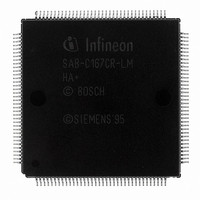SAB-C167CR-LM HA+ Infineon Technologies, SAB-C167CR-LM HA+ Datasheet - Page 46

SAB-C167CR-LM HA+
Manufacturer Part Number
SAB-C167CR-LM HA+
Description
IC MCU 16BIT MQFP-144
Manufacturer
Infineon Technologies
Series
C16xxr
Datasheet
1.SAB-C167CR-LM_HA.pdf
(89 pages)
Specifications of SAB-C167CR-LM HA+
Core Processor
C166
Core Size
16-Bit
Speed
25MHz
Connectivity
CAN, EBI/EMI, SPI, UART/USART
Peripherals
POR, PWM, WDT
Number Of I /o
111
Program Memory Type
ROMless
Ram Size
4K x 8
Voltage - Supply (vcc/vdd)
4.5 V ~ 5.5 V
Data Converters
A/D 16x10b
Oscillator Type
External
Operating Temperature
0°C ~ 70°C
Package / Case
144- BSQFP
Data Bus Width
16 bit
Data Ram Size
4 KB
Interface Type
1xUSART, 1xSSC
Maximum Clock Frequency
25 MHz
Number Of Programmable I/os
111
Number Of Timers
9
Operating Supply Voltage
5 V
Maximum Operating Temperature
+ 70 C
Mounting Style
SMD/SMT
Minimum Operating Temperature
0 C
On-chip Adc
10 bit, 16 Channel
Packages
PG-MQFP-144
Max Clock Frequency
25.0 MHz
Sram (incl. Cache)
4.0 KByte
Can Nodes
1
A / D Input Lines (incl. Fadc)
16
Program Memory
0.0 KByte
Lead Free Status / RoHS Status
Lead free / RoHS Compliant
Eeprom Size
-
Program Memory Size
-
Lead Free Status / Rohs Status
Details
Other names
B167CRLMHAZNP
B167CRLMHAZXP
SAB-C167CR-LMHA
SAB-C167CR-LMHA+
SAB-C167CR-LMHA
SAB-C167CR-LMHAIN
SABC167CRLM-HA
SABC167CRLM-HA
SABC167CRLMHAX
SP000103462
B167CRLMHAZXP
SAB-C167CR-LMHA
SAB-C167CR-LMHA+
SAB-C167CR-LMHA
SAB-C167CR-LMHAIN
SABC167CRLM-HA
SABC167CRLM-HA
SABC167CRLMHAX
SP000103462
3.10
The integrated CAN-Module handles the completely autonomous transmission and
reception of CAN frames in accordance with the CAN specification V2.0 part B (active),
i.e. the on-chip CAN-Module can receive and transmit standard frames with 11-bit
identifiers as well as extended frames with 29-bit identifiers.
The module provides Full CAN functionality on up to 15 message objects. Message
object 15 may be configured for Basic CAN functionality. Both modes provide separate
masks for acceptance filtering which allows to accept a number of identifiers in Full CAN
mode and also allows to disregard a number of identifiers in Basic CAN mode. All
message objects can be updated independent from the other objects and are equipped
for the maximum message length of 8 bytes.
The bit timing is derived from the XCLK and is programmable up to a data rate of
1 Mbit/s. The CAN-Module uses two pins of Port 4 to interface to an external bus
transceiver.
Note: When the CAN interface is to be used the segment address output on Port 4 must
3.11
The Watchdog Timer represents one of the fail-safe mechanisms which have been
implemented to prevent the controller from malfunctioning for longer periods of time.
The Watchdog Timer is always enabled after a reset of the chip, and can only be
disabled in the time interval until the EINIT (end of initialization) instruction has been
executed. Thus, the chip’s start-up procedure is always monitored. The software has to
be designed to service the Watchdog Timer before it overflows. If, due to hardware or
software related failures, the software fails to do so, the Watchdog Timer overflows and
generates an internal hardware reset and pulls the RSTOUT pin low in order to allow
external hardware components to be reset.
The Watchdog Timer is a 16-bit timer, clocked with the system clock divided either by 2
or by 128. The high byte of the Watchdog Timer register can be set to a prespecified
reload value (stored in WDTREL) in order to allow further variation of the monitored time
interval. Each time it is serviced by the application software, the high byte of the
Watchdog Timer is reloaded. Thus, time intervals between 15.5 µs and 254 ms can be
monitored (@ 33 MHz).
The default Watchdog Timer interval after reset is 3.97 ms (@ 33 MHz).
Data Sheet
be limited to 4 bits, i.e. A19 … A16. This is necessary to enable the alternate
function of the CAN interface pins.
CAN-Module
Watchdog Timer
44
Functional Description
V3.3, 2005-02
C167CR
C167SR













